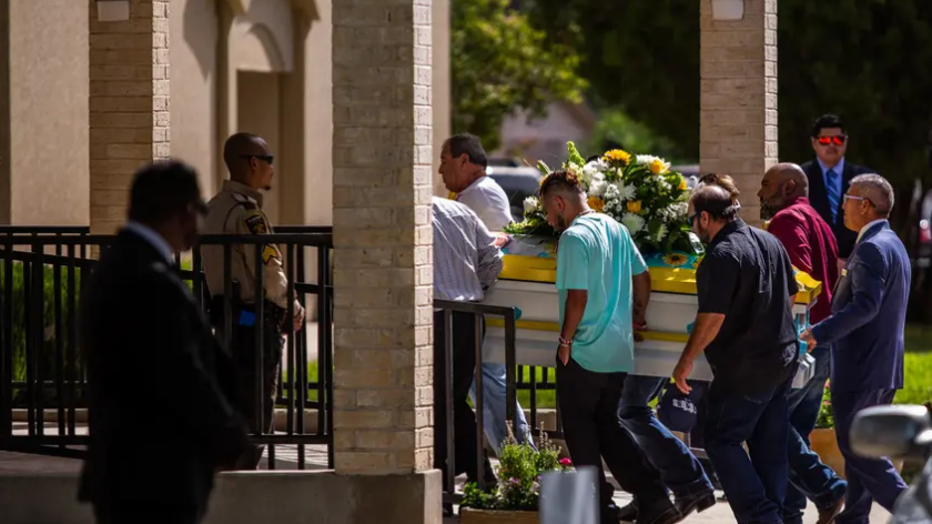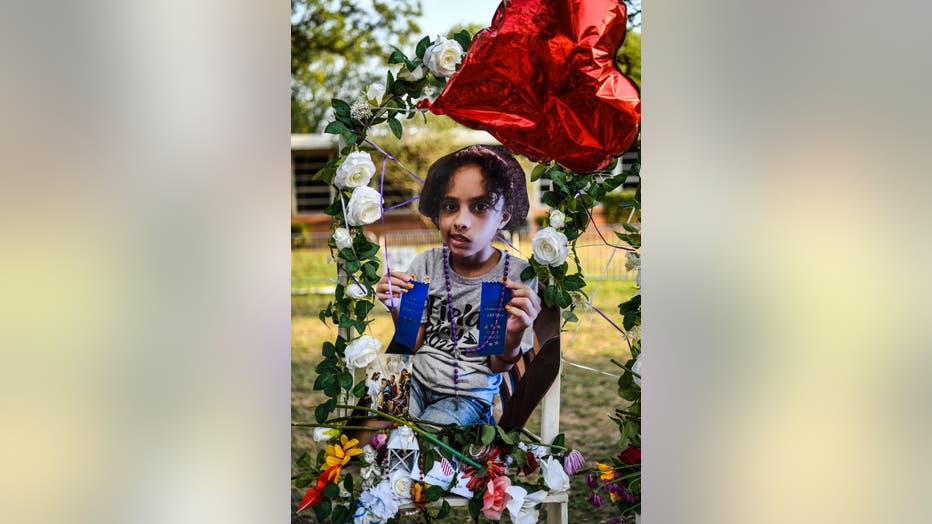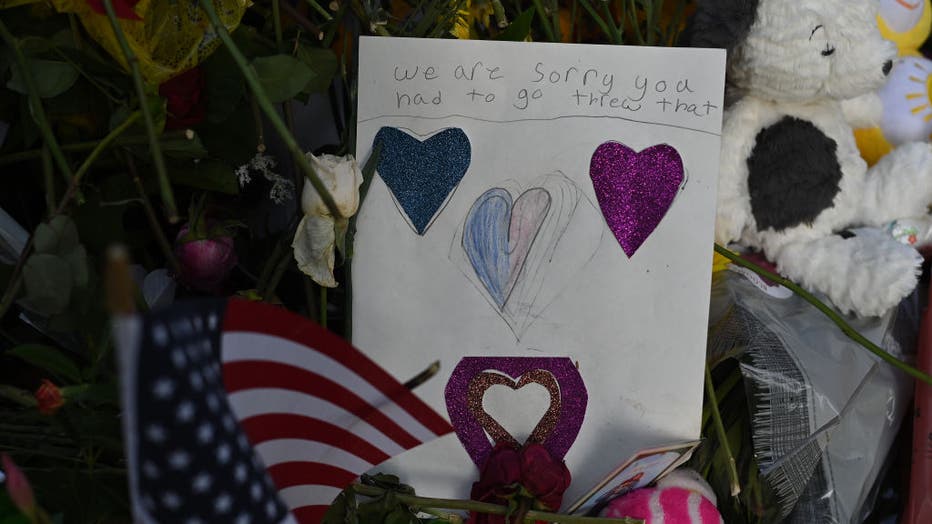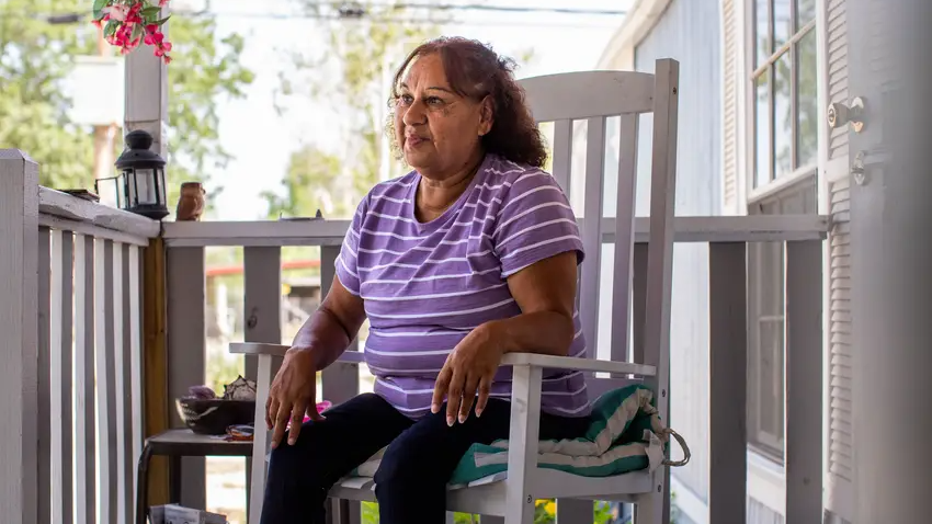The last hearse travels the final mile: Layla Salazar’s burial ends Uvalde funerals for shooting victims
UVALDE, Texas - From Sacred Heart Catholic Church, the path to eternal rest is a 1-mile drive down Fort Clark Road to Hillcrest Memorial Cemetery.
On Thursday, Layla Salazar became the final victim of the Robb Elementary School massacre to make that trip. She was 11 years old.
Since the May 24 school shooting, 20 families have taken turns burying their dead. An unremitting pattern of overlapping visitations and services has laid bare the currents of grief coursing through this small town. Nine of the dead children and two of their teachers passed through Sacred Heart on their way to the cemetery now dappled with fresh mounds of dirt.

Pallbearers carried Layla Salazar’s white, yellow and light blue casket into Sacred Heart Catholic Church on Thursday for her funeral mass in Uvalde. (Kaylee Greenlee Beal for The Texas Tribune)
One last victim, Uziyah Garcia, remains to be buried in his hometown of San Angelo, where the 10-year-old spent his last spring break learning football pass patterns from his grandfather.
For a city trapped in its tragedy, the last of the local funerals marked a turning point. Weeks of ritualized mourning now give way to lifetimes of less structured grief. That last mile to the cemetery is also the first mile of the road to come for those left behind, trying not so much to move on as to some way, somehow find a path forward.
For Catholic families in this mostly Latino community, the funeral procession route begins at the 114-year old Sacred Heart parish; runs past several quiet, residential blocks of modest homes; and then veers left on Lovers Lane to reach the cemetery’s arched entrance.
The repeated funerals have traveled the short stretch of road — sometimes for as long as 20 minutes, oftentimes twice in one day — in solemn affairs interrupted only by the crowing of the roosters that freely roam the neighborhood.
From the first, each procession has passed a sign in the front yard of Ofelia Martinez’s sandy brick home bearing the names of all of the victims. To Martinez, growing up in Uvalde was like growing up with a large extended family. Of the 19 children who died at Robb, she knew 17 of their families.
After a few sleepless nights following the shooting, she made the quick trip to San Antonio to pick up the sign made by a family friend, setting it up as soon as she got back in time for the funeral of Amerie Jo Garza, the first victim whose procession passed down Fort Clark Road. Martinez wanted all the families to know they would not be abandoned in their grief.
"That’s what this community is about," Martinez said on a recent evening in between back-to-back funerals. "I wanted them to see it."
On Thursday, the mid-morning procession for Layla Salazar was led by a silver hearse carrying a sweet little girl’s casket — white and yellow with sunflowers against a blue background on the lid.
Layla was remembered by her family for her love of dancing, the Dallas Cowboys and singing — with her father on the way to school and her mother on the way back. Guns N’ Roses’ "Sweet Child O’ Mine" was a favorite. A note added to her tribute at a memorial on the grounds of Robb Elementary assured her father that she was now singing the tune with the angels but not to fret because the song was "still ours." She was also a runner — and a fast one at that, taking home six first-place ribbons from a recent field day.
"If you aren’t first, you’re last," she would say, according to her obituary.

A photo of Layla Salazar, 11, who died in the mass shooting, is placed at a makeshift memorial at Robb Elementary School in Uvalde, Texas, on May 30, 2022. - Grieving families were to hold the first funerals Tuesday for Texas shooting victims one wee
Layla’s funeral came on a quiet morning. As Uvalde’s distance from the shooting grows, media mobs have departed and crowds of mourners and visitors have thinned. Two weeks before, the line to visit the memorial at the elementary school stretched for several blocks, locals flipped burgers on Main Street to feed their neighbors, and a busy donation car wash was running nearby to collect funds for hurting families.
At one memorial, the mourners brought with them so many white pillar candles, set in a halo encircling the white crosses bearing the names of the dead, that the scent of melted wax under the harsh sun permeated the entire square.
In the early afternoon the day before Layla’s funeral, the memorial was almost empty, save for a handful of visitors clutching churros handed out by an eager visiting vendor.
Initially, the funerals had been carried out at an almost unforgiving pace. In the first week, families of three children held funerals in just one day. On one evening, the small white feathers on a pair of cutout wings perched over the gravesite of Eliahna Torres fluttered in the wind as grave diggers nearby prepared twin ditches for cousins Jayce Luevanos and Jailah Silguero to be buried side by side the following day.
Their morning burials would be followed by the funeral for Jackie Cazares, whose loved ones filled the time before her burial with a visit to the memorial at the elementary school, crying quietly in front of the large cutouts of photos of the children displayed under white wooden arches lined in plastic white roses.
The quieter road ahead for this grieving community was perhaps best captured at the cemetery at dusk on the eve of Layla’s funeral, when loved ones of the children already buried visited graves. Some crouched down, reflecting quietly next to mounds of dirt that had not yet receded into the Earth; others tended to the flowers and tributes left behind. One family gathered around a grave with drinks in hand and young children playing on blankets laid out nearby.

Community mourns victims of Uvalde elementary school shooting
The community is mourning the victims of last week's school shooting as funerals start this week. All of this, along with growing outrage over what appears to be a bungled response to the mass shooting by local law enforcement.
The charge of trying to ease some of the families into the uncertain road ahead has partly fallen to Father Eduardo Morales, known locally as "Father Eddy," of Sacred Heart.
Meeting with each of the grieving families to prepare for funeral Masses, Morales gently encouraged them to share stories of their loved ones that he could incorporate into the services. But he was also attempting to offer the families an opening to celebrate their lives beyond the remembrances of their deaths. To help them realize that their children will continue to live with them.
"You will hear me say it at every funeral Mass that I would hope their tears of sadness will become tears of joy, that they remember their children and allow them to continue to live because if you’re only coming to celebrate a death, you’re never going to find happiness. We’re here to celebrate their life," Morales said in an interview.
The families of Robb will remain inextricably linked, each starting every day knowing they will live it out differently than they should have, without their children or their mothers.
But it’s likely their grief will play out in different ways.

UVALDE,TX - June 1: Flowers, messages, balloons, stuff animals, toys and other items left by mourners commemorating the students and teachers of the Robb Elementary Schools mass shooting are displayed at the City of Uvalde Town Square on June 1, 2022
Some might turn inward, closing themselves off from a world that no longer includes their child. If previous school shootings are an indication, some will seek purpose in their loss, pushing for change that may never come. Some have already started.
Speaking to the U.S. House’s oversight and reform committee last week, the parents of 10-year-old Lexi Rubio tearfully described how she had recently been recognized for her straight A’s and her dreams to be a lawyer. She would’ve made a positive change in the world, her mother, Kimberly, said, if only she had been given the chance to grow up. Her mother also recounted their frantic search after the shooting, how she ran barefoot across town from the local hospital to the school in her desperation to find Lexi.
"When she knew she was right, and she so often was, she stood her ground," Kimberly Rubio told the members of Congress with her husband, Felix, by her side. "She was firm, direct, voice unwavering. Today we stand for Lexi, and as her voice we demand action."
From her house at the corner of Fort Clark and Lovers Lane, Olga Ojeda watched every single procession go by. She’d step out of her robin-blue trailer home, sit on a black patio chair in the shade, and stand quickly when the fire truck or patrol cars turned the corner, signaling the arrival of the processions.

Olga Ojeda waited on her front porch in Uvalde on Thursday for Layla Salazar’s processional from Sacred Heart to pass by on the way to the cemetery.
It’s her way of holding vigil for the families, similar to the way outside support for her community, even from faraway places, has helped the community feel less lonely in tragedy. With the funerals coming to a close, she believes what the families need now is time to heal. But she worries that the end of the ritualized mourning may release a different kind of anguish over who is to blame and what should happen next.
"How sad," Ojeda said in Spanish as she watched Layla’s procession go by on Thursday. "Think about all the people who passed by here all these days."
Just a few houses down, Martinez has been cooking. Enchiladas. Chicken casserole. Spaghetti. Like others, she’s still trying to find ways to help, so she joined a local meal train for the grieving families. At the end of the week, she’ll also cook for the funeral home employees to offer them a reprieve at the end of their grueling work for the Robb families.
Martinez is making plans to find a place for the sign that’s been sitting outside her home now that it’s served its purpose. She’s considering adding it to what’s left of the memorial at the school.
The memorial once received so many visitors that the patchy grass on the grounds has turned into a dusty lot lined by floral arrangements burnt to a crisp as fewer and fewer visitors replace them with fresh tributes.
Martinez’s sign will stand in the shadow of a row of boarded-up windows, shuttering away the classrooms through which tragedy arrived.
Jinitzail Hernández contributed to this report.
More from The Texas Tribune

